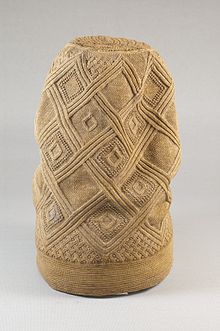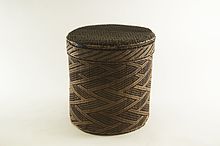225:
88:
217:
80:
17:
903:
642:
208:: "The gentry have a kind of straw garment on their shoulders, which reaches down to their wastes, curiously wrought, wit their arms coming out at two slits, and ends in two tassels which hang down on the right side. About their wastes they have a cloth girth, which on one side hangs down to the ground."
232:
Kongo baskets were displays of prestige and wealth. They were given as gifts to notables and foreigners as well as used by the wealthy and elite. These baskets often held prestige goods of great status that were given to the king. Special baskets also featured prominently in the ritual practice and
249:
traditions. Both Kongo and Kuba art flourished within a hierarchical, courtly structure, and each society accorded high value to the arts of ceremony, personal adornment, and display. They also had in common the use of raffia palm fiber as the foundation of their weaving arts. Kongo and Kuba also
236:
Kongo baskets were fabricated with twill-patterned raffia fiber sides over a solid inner structure of wood or bark. The baskets' dynamic configurations of zig zags, diamonds, and chevrons arise naturally from a twill or plaiting technique using died or natural raffia fibers. They evolved into
163:
to express their belief that hair grew in a circular pattern in this spot. According to Moraga, "The crows of caps are typically worked with a spiraling lattice or openwork pattern that differs from the interlacing geometric designs on the sides- as if to mimic the whorls of the hair while
183:
is unique among
Central African ceremonial garments for having a traceable chronology that spans several hundred years and for the fact that it can be linked with a specific historical figure. Antonio Manuel was a Kongo ambassador to the
158:
Nearly all caps are constructed in spiral form, working from the center of the crown to the edge of the hat border. Mpu were designed to cover the spiritually vulnerable top of the head. The Kongo people used to the term
224:
685:
128:
signified the authority invested in a person elected to an office of sacred leadership. Moraga writes that "it was also a potent cosmological symbol connecting the chief (
748:
237:
culturally significant patterns, which were translated into other media, such as funerary terracottas. Baskets have also been made with reed fibers.
151:, meaning mother) is an unstructured domed style decorated with high-relief patterns that was bestowed on new chiefs during investiture rites. The
44:
palm tree served as the foundation of the Kongo weaving arts. This material imposed constraints that were overcome to produce varied and ingenious
690:
250:
share many geometric motifs, sacred signs, symbolic insignia, and types of textiles and prestige regalia, as well as techniques of fabrication.
695:
826:
87:
99:
was a supple knotted cap of golden raffia or pineapple fiber and a vital component of the chief's regalia, which also included a
488:
889:
345:
728:
658:
951:
678:
40:), the woven arts were emblematic of kingship and nobility. The coarse filament stripped from the fronds of the
454:
410:
385:
201:
805:
863:
216:
132:), the kin group, and the village to a mythic place of origin as well as a specific territorial domain (
936:
853:
481:
200:
in Kongo) in a memorial bust commissioned by the Pope after
Antonio Manuel's death. In 1688 in Angola,
931:
426:
Cited in Gibson, Gordon; Cecilia McGurk (1977). "High Status Caps of the Kongo and Mbundu
Peoples".
884:
879:
821:
926:
447:
The four moments of the sun : Kongo art in two worlds. National
Gallery of Art, Washington
836:
848:
616:
474:
941:
8:
663:
611:
245:
Although separated by time and geography, there are many parallels between the Kongo and
800:
778:
768:
946:
858:
793:
788:
743:
450:
406:
381:
341:
29:
843:
758:
711:
621:
79:
907:
753:
668:
228:
Large round basket with cover, from the collection of the
Cincinnati Art Museum.
773:
673:
566:
920:
763:
721:
576:
246:
117:
25:
375:
338:
Weaving abstraction : Kuba textiles and the woven art of
Central Africa
497:
155:
is a taller, conical cap worn by the paramount leaders of the Kongo realm.
113:
220:
Large round basket with cover, from the collection of the
Brooklyn Museum
511:
307:
Histoire et numismatique des monnaies du Congo du XVe siècle à nos jours
20:
Cushion Cover, from the collection of the
Ethnographic Museum, Stockholm
601:
571:
531:
561:
365:. Toronto: University of Toronto Press, Scholarly Publishing Division.
16:
831:
581:
164:
accentuating the extraordinary protection afforded by the headwear."
91:
Mpu, from the collection of the
Koninklijk Museum voor Midden-Afrika
591:
551:
516:
185:
902:
626:
536:
521:
45:
33:
204:
priest
Girolamo Merolla recorded the following description of a
736:
606:
586:
526:
466:
121:
41:
378:
Crowning achievements : African arts of dressing the head
641:
546:
425:
105:
37:
686:
Textile manufacture during the British Industrial Revolution
294:
Résistances africaines sur la Côte d'Angola au XVIIIe siècle
631:
596:
556:
541:
189:
376:
Mary Jo Arnoldi and Christine Mullen Kreamer, ed. (2002).
67:
444:
48:
formats and structures. Raffia cloth (singular :
311:
Les monnaies du Congo - L’histoire et la numismatique
109:), a reliquary basket, the double bell, and a stool.
380:. Seattle, Wash.: University of Washington Press.
369:
918:
445:Thompson, Robert Farris; Cornet, Joseph (1981).
691:Textile manufacturing by pre-industrial methods
361:Volavka, Zdenka (1988). Wendy A. Thomas (ed.).
240:
179:is an openwork tunic made of raffia fiber. The
83:Mpu, from the collection of the Brooklyn Museum
482:
394:
363:Crown and Ritual: The Royal Insignia of Ngoyo
331:
329:
327:
325:
323:
321:
319:
281:Power, Cloth and Currency on the Loango Coast
696:Timeline of clothing and textiles technology
188:who died in 1608, shortly after arriving in
103:mesh tunic, a woven chest bag, a charm bag (
354:
489:
475:
316:
400:
223:
215:
86:
78:
15:
360:
270:, p. 111, Revue-Numismatique, 2001
919:
335:
470:
403:Weaving in Africa south of the Sahara
283:, University of Wisconsin Press, 1986
340:. Washington, D.C.: Textile Museum.
167:
13:
749:Indigenous peoples of the Americas
640:
401:Schaedler, Karl-Ferdinand (1987).
120:, and relates peoples in northern
14:
963:
449:. Washington, D.C.: The Gallery.
268:Aperçu sur les monnaies d'Afrique
901:
496:
438:
419:
336:Moraga, Vanessa Drake (2011).
299:
286:
273:
260:
192:. He is represented wearing a
1:
253:
827:Conservation and restoration
241:Parallels with Kuba textiles
7:
890:Textile manufacturing terms
139:There are several types of
10:
968:
854:Mathematics and fiber arts
428:The Textile Museum Journal
296:, Présence Africaine, 2006
211:
898:
872:
814:
704:
651:
638:
504:
233:belief of Kongo peoples.
68:Chief of nobleman's cap,
64:) was used as currency.
313:, Weyrich Edition, 2015
952:Textile arts of Africa
645:
229:
221:
92:
84:
21:
729:Australian Aboriginal
659:Clothing and textiles
644:
405:. München: Panterra.
227:
219:
90:
82:
19:
864:Units of measurement
908:Clothing portal
705:Regional and ethnic
679:Indian subcontinent
305:M. Yandesa Mavuzi,
279:Phyllis M. Martin,
837:wearable fiber art
646:
230:
222:
93:
85:
22:
937:Culture of Africa
914:
913:
28:and its vassals (
959:
932:Kingdom of Kongo
906:
905:
622:Textile printing
491:
484:
477:
468:
467:
461:
460:
442:
436:
435:
423:
417:
416:
398:
392:
391:
373:
367:
366:
358:
352:
351:
333:
314:
303:
297:
290:
284:
277:
271:
264:
56:, plural :
967:
966:
962:
961:
960:
958:
957:
956:
917:
916:
915:
910:
900:
894:
868:
810:
700:
647:
636:
500:
495:
465:
464:
457:
443:
439:
424:
420:
413:
399:
395:
388:
374:
370:
359:
355:
348:
334:
317:
304:
300:
292:Alain Anselin,
291:
287:
278:
274:
265:
261:
256:
243:
214:
173:
147:(from the root
77:
12:
11:
5:
965:
955:
954:
949:
944:
939:
934:
929:
912:
911:
899:
896:
895:
893:
892:
887:
882:
876:
874:
870:
869:
867:
866:
861:
856:
851:
846:
841:
840:
839:
829:
824:
818:
816:
812:
811:
809:
808:
803:
798:
797:
796:
791:
783:
782:
781:
776:
771:
766:
761:
756:
746:
741:
740:
739:
731:
726:
725:
724:
719:
708:
706:
702:
701:
699:
698:
693:
688:
683:
682:
681:
676:
666:
661:
655:
653:
652:History of ...
649:
648:
639:
637:
635:
634:
629:
624:
619:
614:
609:
604:
599:
594:
589:
584:
579:
574:
569:
564:
559:
554:
549:
544:
539:
534:
529:
524:
519:
514:
508:
506:
502:
501:
494:
493:
486:
479:
471:
463:
462:
455:
437:
418:
411:
393:
386:
368:
353:
346:
315:
298:
285:
272:
258:
257:
255:
252:
242:
239:
213:
210:
172:
166:
76:
66:
60:; also called
9:
6:
4:
3:
2:
964:
953:
950:
948:
945:
943:
940:
938:
935:
933:
930:
928:
927:Kongo culture
925:
924:
922:
909:
904:
897:
891:
888:
886:
883:
881:
878:
877:
875:
871:
865:
862:
860:
857:
855:
852:
850:
849:Manufacturing
847:
845:
842:
838:
835:
834:
833:
830:
828:
825:
823:
820:
819:
817:
813:
807:
804:
802:
799:
795:
792:
790:
787:
786:
784:
780:
777:
775:
772:
770:
767:
765:
762:
760:
757:
755:
752:
751:
750:
747:
745:
742:
738:
735:
734:
732:
730:
727:
723:
720:
718:
715:
714:
713:
710:
709:
707:
703:
697:
694:
692:
689:
687:
684:
680:
677:
675:
672:
671:
670:
667:
665:
662:
660:
657:
656:
654:
650:
643:
633:
630:
628:
625:
623:
620:
618:
615:
613:
610:
608:
605:
603:
600:
598:
595:
593:
590:
588:
585:
583:
580:
578:
577:Passementerie
575:
573:
570:
568:
565:
563:
560:
558:
555:
553:
550:
548:
545:
543:
540:
538:
535:
533:
530:
528:
525:
523:
520:
518:
515:
513:
510:
509:
507:
503:
499:
492:
487:
485:
480:
478:
473:
472:
469:
458:
452:
448:
441:
433:
429:
422:
414:
408:
404:
397:
389:
383:
379:
372:
364:
357:
349:
347:9780874050363
343:
339:
332:
330:
328:
326:
324:
322:
320:
312:
308:
302:
295:
289:
282:
276:
269:
263:
259:
251:
248:
238:
234:
226:
218:
209:
207:
203:
199:
195:
191:
187:
182:
178:
171:
165:
162:
156:
154:
150:
146:
142:
137:
135:
131:
127:
123:
119:
115:
110:
108:
107:
102:
98:
89:
81:
75:
71:
65:
63:
59:
55:
51:
47:
43:
39:
35:
31:
27:
26:Kongo Kingdom
18:
885:Sewing terms
880:Dyeing terms
716:
505:Fundamentals
498:Textile arts
446:
440:
431:
427:
421:
402:
396:
377:
371:
362:
356:
337:
310:
306:
301:
293:
288:
280:
275:
267:
266:P. Edoumba,
262:
247:Kuba textile
244:
235:
231:
205:
197:
193:
180:
176:
174:
169:
160:
157:
152:
148:
144:
140:
138:
133:
129:
125:
111:
104:
100:
96:
94:
73:
69:
61:
57:
53:
49:
23:
942:African art
785:Indonesian
567:Nålebinding
921:Categories
873:Glossaries
602:Rug making
572:Needlework
532:Embroidery
456:089468003X
412:3767902702
387:0930741439
254:References
143:hats. The
859:Recycling
832:Fiber art
674:Byzantine
582:Patchwork
947:Textiles
844:Industry
822:Blocking
789:Balinese
733:Burmese
664:Quilting
612:Spinning
592:Quilting
552:Knitting
517:Beadwork
512:Appliqué
206:Kinzembe
202:Capuchin
196:(called
194:Kinzembe
181:Kinzembe
177:Kinzemba
170:Kinzembe
168:Chief's
101:kinzembe
815:Related
779:Oaxacan
769:Mexican
759:Mapuche
712:African
627:Weaving
562:Macramé
542:Felting
522:Crochet
212:Baskets
186:Vatican
54:Libongo
50:Lubongo
46:textile
34:Kakongo
24:In the
801:Korean
774:Navajo
754:Andean
737:Acheik
617:Stitch
607:Sewing
587:Plying
537:Fabric
527:Dyeing
453:
409:
384:
344:
145:ngunda
124:, the
122:Angola
118:Mbundu
74:Ngunda
58:Mbongo
42:raffia
30:Loango
806:Māori
794:Sumba
744:Hmong
717:Kongo
547:Fiber
198:nkutu
161:nzita
153:ngola
130:mfumu
114:Kongo
106:nkisi
62:Mpusu
38:Ngoyo
764:Maya
722:Kuba
669:Silk
632:Yarn
597:Rope
557:Lace
451:ISBN
434:(4).
407:ISBN
382:ISBN
342:ISBN
190:Rome
175:The
136:)."
112:For
95:The
309:ou
149:ngu
141:mpu
134:nsi
126:mpu
97:mpu
72:or
70:Mpu
923::
432:IV
430:.
318:^
116:,
52:,
36:,
32:,
490:e
483:t
476:v
459:.
415:.
390:.
350:.
Text is available under the Creative Commons Attribution-ShareAlike License. Additional terms may apply.









